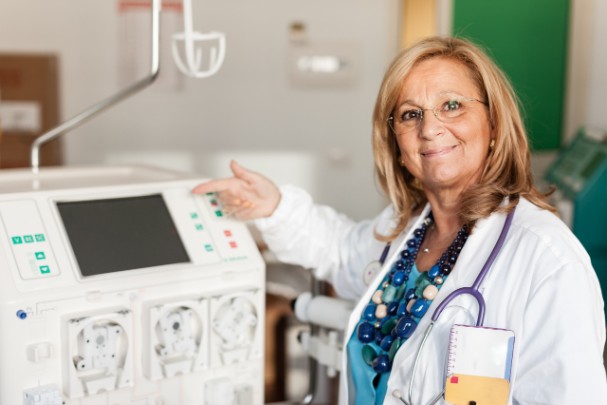St. Luke's Health joins CommonSpirit.org soon! Enjoy a seamless, patient-centered digital experience. Learn more

According to the National Kidney Foundation, chronic kidney disease (CKD) affects about 37 million people in the U.S. alone, and about 90% of those don’t even know they have it. The only cure for stage 5 CKD is a kidney transplant, but before that, many people receive ongoing treatment through dialysis, a simple procedure that performs the functions of a healthy kidney.
If you receive a CKD diagnosis, your nephrologist will work to determine what stage you are currently experiencing. There are five stages, with stage 1 meaning your kidneys are functioning at about 90-100% of their normal capacity due to some kidney damage and stage 5 meaning your kidneys are functioning at less than 15%. Stage 5 CKD is also known as kidney failure. To determine what stage of CKD you are currently in, your doctor will take a blood sample and measure the amount of creatinine in your blood and factor in your age, body size, and gender.
The kidneys are responsible for filtering excess fluids, salt, and waste products from the blood. When someone has kidney failure, their kidneys can’t remove these items efficiently, causing them to build up in the body.
“Dialysis is a treatment option for those with significant kidney failure, and the process of dialysis is to replace many functions of normal kidneys,” said Dr. Jingyin Yan, nephrologist at Baylor St. Luke’s Medical Center.
While there are different types of dialysis, all of them begin with a doctor creating an access port in the body through which your blood can travel into an artificial kidney or dialysate (a liquid that absorbs the waste products) can enter the body.
There are two main types of dialysis:
Every month, our nephrology team at Baylor St. Luke’s Medical Center performs over 800 inpatient dialysis treatments. We offer all dialysis procedures, including continuous filtering therapies. As a U.S. News & World Report High Performing Hospital in nephrology for 2019-2020, our team can provide the support you need in any stage of CKD.
If you notice signs of kidney disease, such as cramps, nausea, vomiting, loss of appetite, blood in the urine, or swelling, schedule an appointment with your primary care physician for evaluation and diagnosis.
If you have chronic kidney disease, request a consultation with a St. Luke’s Health nephrologist to learn about your treatment options, including your eligibility for transplantation. Our Kidney Transplant Program is dedicated to providing the highest level of patient care and expanding the frontiers of research in nephrology.
Sources:
National Kidney Foundation | Dialysis
National Kidney Foundation | Estimated Glomerular Filtration Rate (eGFR)
American Kidney Fund | Chronic kidney disease (CKD)
National Kidney Foundation | KIDNEY DISEASE: THE BASICS
MedicineNet | What are the types of dialysis? How do they work?
Looking for a doctor? Perform a quick search by name or browse by specialty.